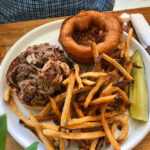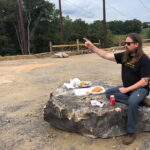A corner of Downtown Waynesville went back in time this past weekend for a ceremony and commemoration of Confederate veterans.
On Saturday, May 10, the state’s Confederate Memorial Day, members of the 22nd North Carolina Company B encamped on the courthouse lawn, held military exercises in uniform and gave a 21-gun salute during a wreath-laying ceremony at the Haywood County Courthouse monument for Confederate veterans.
The event began with the reading of nearly 300 names of Haywood County soldiers who died in the war. More than 1,400 native sons of Haywood fought and died in battles ranging from Fredericksburg to Sharpsburg and Chickamauga to the Shenandoah Valley. According to military records, Haywood County soldiers are listed in campaigns with Gen. Robert E. Lee’s Army of Northern Virginia, the armies of Gen. Braxton Bragg and Joseph Johnston in Georgia and Tennessee, and regiments in Alabama, Mississippi, eastern Louisiana and Maryland.
“From Big Bethel through Appomattox and beyond, Haywood’s heroes could be found at almost every major battle fought during the war,” said Derrick Shipman, commander of the Capt. Julius Welch Camp 229 Sons of Confederate Veterans. The chapter is named in honor of Capt. Julius Welch, who died at the Battle of Piedmont in Northern Virginia in 1864. As the story goes, Col. W.W. Stringfield, a Tennessee-born officer who later settled in Waynesville and ran the White Sulphur Springs Hotel, was carrying a wounded Welch off the battlefield when he died in Stringfield’s arms.
Many of Haywood’s Confederate soldiers who died in the war perished in Union prisons. According to Shipman, at least 70 Haywood County soldiers are buried at Oakwood Cemetery in Chicago, Ill., making it second only to Green Hill Cemetery in Waynesville as having the most known graves of Haywood County Confederate veterans.
For the re-enactors, the weekend encampment was more than a chance to dress up and be soldiers for a day. It was an opportunity to remember their ancestors and share 19th century history with local residents and tourists, who snapped photographs and watched the soldiers in gray march, relax among their “A” tents, and receive orders as they would have nearly 150 years ago.
“We hope to honor our ancestors and remember what they did,” said Shipman, who gave a detailed account of Haywood’s involvement in the war. In 1860, Waynesville only had about 100 residents, but it was invaded four times during the war by Union forces, the last being in May 1865, when Confederate forces met Union infantry and exchanged gunfire. It is considered by many historians to be the last shot fired in the war east of the Mississippi River. The Thomas Legion led by Col William Holland Thomas — a Haywood native, adopted Cherokee and later chief as well as a U.S. Congressman — surrendered to Union forces at the Battle House (a site that is today next to the Waynesville Town Hall on Main Street) one month after Lee had surrendered at Appomattox.



















